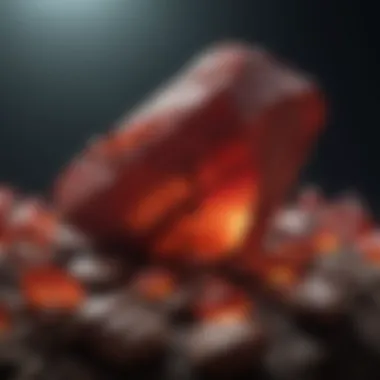Discovering Red Minerals: Nature's Vivid Palette


Intro
Red minerals and rocks are not just visually striking; they are crucial in understanding geological processes and human culture. This article aims to explore the diverse aspects of these minerals and rocks, from their origins to their applications in various fields. Rock and fossil collectors will find value in recognizing how these specimens fit into the broader scope of geology and cultural significance.
History and Origins
Overview of Collectibles, Rocks, and Fossils
The world of red minerals and rocks is rich and varied. Collectors often seek out specimens like red jasper, garnet, and hematite. Each type of rock tells its own story of how it formed, often under extreme conditions that span millions of years. These collectibles are not merely aesthetic objects; they are records of the Earth’s history. When one examines these rocks, they witness the geological processes that give rise to various formations, including magma and sedimentary processes.
Historical Significance and Cultural Impact
Historically, red minerals played significant roles in various cultures. For instance, ochre has been used in art and rituals by numerous ancient civilizations. The color red often symbolizes emotions, power, and life across many cultures. From ancient Egypt to indigenous cultures worldwide, red minerals and rocks have been used for decorative, functional, and spiritual purposes. Their historical significance adds a layer of intrigue for collectors, who look beyond the physical properties to appreciate their cultural impact.
"The hues of red in minerals often represent life and vitality, linking the Earth and humanity in profound ways."
Identification and Classification
Guide to Identifying Rocks and Fossils
Identifying red minerals requires attention to several characteristics. First, one should examine the color, as this can range from deep crimson to lighter shades of rust. Next, consider the texture and luster: some specimens may be glossy while others have a matte finish. Hardness is another crucial factor; using the Mohs scale can help determine this. Collectors often rely on simple tools like a hand lens or a hammer to assist in this process.
For a more structured approach, a consistent classification system helps in organizing findings. Each type of mineral can be classified based on its chemical composition and structural properties.
Common Types and Variations
Some of the commonly found red minerals include:
- Hematite: Known for its metallic luster and high iron content, it often has a reddish hue.
- Garnet: Appears in diverse shades of red and is used both in jewelry and industrial applications.
- Red Jasper: An opaque variety of chalcedony, appreciated for its earthy tones.
- Cinnabar: A mercury sulfide mineral, notable for its bright red color and use in historical pigments.
Understanding these variations enriches the collector's experience and informs their choices in both acquisition and display.
Preamble to Red Minerals and Rocks
Red minerals and rocks are not just visually striking; they also hold significant geological, historical, and cultural relevance. These natural formations provide a glimpse into the Earth’s processes, showcasing the dynamic history of our planet. Understanding red minerals can inform collectors, hobbyists, and geologists about the formation processes and environments that produce them, revealing layers of complexity that underlie their vibrant colors.
The study of red minerals offers various benefits. For rock enthusiasts, these specimens present opportunities for exploration and display. Their vivid hues can transform a collection, making it not only diverse but also visually appealing. Moreover, the understanding of these materials encourages responsible collecting and showcases the need for preservation of geological sites.
When examining red minerals, it is essential to define what makes a mineral red. They can range from deep crimson hematite to vibrant poppy jasper, each with unique properties and formation histories. This article aims to unpack these distinctions. It will also dive into the rich historical narratives tied to red rocks, emphasizing their symbolic meanings in cultures worldwide.
The exploration of red minerals enlivens the understanding of both the Earth and the human experience, linking natural beauty to cultural practices.
In this introductory section, we will delve into the specific attributes of red minerals and trace the historical significance of red rocks. Doing so will not only enhance our appreciation for these remarkable specimens but also provide insight into their multifaceted roles within both geological and cultural frameworks.
Defining Red Minerals
Red minerals are defined by their characteristic color, which typically arises from the presence of iron oxides or other mineral constituents that reflect red wavelengths of light. Hematite is a prime example wherein iron provides a rich, rust-colored appearance. Similarly, minerals like jasper and cinnabar showcase variations in shades due to differing compositions.
These minerals can be anodized from primary geological processes, such as metamorphism or sedimentation, which are crucial for formation and alteration. Different environmental contexts contribute to these properties, making red minerals a diverse field of study. The appeal of such minerals lies not only in their aesthetics but also in the stories they tell about the Earth's history and composition.
Historical Perspectives on Red Rocks
Historically, red rocks have played a pivotal role in human culture and civilization. Ancient societies utilized these minerals in art, tools, and as symbols of power or protection. For instance, hematite was ground to create pigment for cave paintings, linking the mineral with early human expression. Beyond aesthetics, red stones have been associated with spiritual significance across various cultures, representing attributes like strength, vitality, and protection against harm.
This historical context offers valuable insights into how humans have interacted with the landscape over time. The colors of red stones have inspired narratives and helped in rituals. Understanding these cultural ties enhances the appreciation for red minerals, positioning them as more than mere geological samples but as key players in the narrative of humanity’s relationship with nature.
Geological Origins of Red Minerals
Understanding the geological origins of red minerals is essential in appreciating their formation and significance. The processes involved in their development can lead to distinct characteristics and properties admired by collectors and enthusiasts. By exploring these origins, readers can gain better insight into the environments where red minerals occur, enhancing their knowledge about collection strategies and value assessments.
Formation Processes
Magmatic Processes
Magmatic processes refer to the formation of minerals through the cooling and solidification of magma. This is a key aspect because it creates some of the most striking red minerals, such as Hematite. These minerals often exhibit vibrant reddish hues due to iron oxides present during the crystallization. The benefit of focusing on magmatic processes is the diverse formations they produce, often located in volcanic regions. One unique feature of magmatic processes is their influence on minerology at various depths, resulting in different mineral compositions. However, the disadvantage lies in the accessibility; many deposits are found deep underground, making them challenging for casual collectors to find.


Sedimentary Formation
Sedimentary formation involves the accumulation of minerals through sedimentation processes over time. This formation is particularly relevant for red minerals found in sandstones or shales. Jasper is a prime example; its formation process allows various colors to intermix, resulting in the rich patterns collectors seek. The key characteristic of sedimentary processes is the role of external elements like water, which can transport and deposit minerals. This makes them beneficial for finding red minerals in surface layers close to rivers or lakes. The unique feature is the potential for fossils in the same layers, offering collectors additional finds. On the downside, sedimentary environments can lead to more dilute concentrations of valuable minerals, making them less prolific.
Metamorphic Alterations
Metamorphic alterations occur when existing minerals transform under heat and pressure. This process is crucial for understanding how red minerals can evolve from pre-existing rock types. Cinnabar, for example, can arise from the alteration of mercury-bearing minerals during metamorphic changes. The benefit of studying metamorphic alterations lies in recognizing how the stress and heat modify mineral characteristics, leading to new gem types. A unique feature of this process is its capacity to generate diverse minerals from the same parent rock, broadening opportunities for collectors. Nonetheless, these deposits can be localized and might not be as widespread, which can restrict collecting opportunities.
Common Environments for Occurrence
Volcanic Regions
Volcanic regions are rich in geological activity and often host red minerals such as Hematite and Poppy Jasper. The intense heat and pressure within these areas often lead to the formation of unique mineral structures. Such regions are beneficial to collectors because they provide a rich variety of specimens. The key characteristic is the energetic environment promoting rapid mineral formation. The advantage of exploring volcanic regions is the potential for discovering high-quality specimens not found elsewhere. However, such locations can be dangerous and may require specific precautions.
Desert Landscapes
Desert landscapes contribute to the formation of red minerals through weathering and erosion processes. Jasper is commonly found here, where wind and water gradually shape the stones. The key characteristic of these areas is the exposure of rocks, making it easier for collectors to find specimens. Furthermore, these landscapes often reveal striking contrasts between red minerals and surrounding sand. The advantage is that mineral layers are more accessible due to a lack of vegetation. A disadvantage, however, is the harsh environment, which can make prolonged exploration challenging.
Mountain Ranges
Mountain ranges serve as vital habitats for many red minerals. They provide both magmatic and metamorphic processes that shape the landscape. Cinnabar can often be sourced from mountainous terrains, where geological pressures create suitable conditions for its formation. The key characteristic of mountain ranges is their diversity; varying altitudes can lead to unique formations and mineral collectibilities. The high altitude environments can yield specimens that are seldom found in lower elevations. However, accessibility can be an issue; often, tackling these terrains requires considerable physical effort and knowledge of the environment.
Prevalent Red Minerals
Red minerals are significant in the geological and cultural landscape due to their unique properties and diverse occurrences. Their vibrant hues make them visually striking, and many hold substantial historical and practical value. Impacts of these minerals extend beyond aesthetics; they have applications in various industries, alongside deep cultural implications. For enthusiasts, understanding prevalent red minerals enhances collecting pursuits and fosters a deeper appreciation for the earth's natural treasures.
Hematite: Iron's Red Ore
Hematite is renowned for its metallic luster and red coloration, stemming from its iron oxide composition. This mineral is one of the primary ores of iron and plays a crucial role in steel production. The presence of hematite signifies environments rich in iron, common in sedimentary deposits. Collectors often seek this mineral not only for its economic importance but also for its aesthetic appeal. Hematite can be found in forms such as botryoidal or massive habits, making it a versatile addition to any collection.
Jasper: The Variegated Stone
Jasper is a form of chalcedony, and unlike hematite, it is noted for its intricate patterns and colors. This sedimentary rock contains a variety of impurities, leading to its diverse appearances. Each piece of jasper tells a unique story, reflecting its geological history. Often used in jewelry and ornamental objects, the stone is valued for both its clarity and vivid hues. Collectors appreciate jasper for its beauty and significance as a historical artifact, often featured in ancient cultures for decorative purposes.
Poppy Jasper: A Unique Variety
Poppy jasper, characterized by its bright red color accented with black and yellow spots, is a unique variation of jasper. This mineral is believed to energize the wearer and is often used in metaphysical practices. Unlike more common forms of jasper, poppy jasper's distinct patterns make it a coveted specimen among collectors. It is found in specific locations, which contributes to its rarity and desirability in the market. Those who collect it often appreciate not just the stone itself but also its purported metaphysical properties.
Cinnabar: The Red Mercury Sulfide
Cinnabar is notable for its striking vermilion color and composition, primarily as mercury sulfide. Due to its mercury content, it has historical significance but must be handled with caution. This mineral was historically used to create pigments, particularly in art, as well as in alchemical practices. Due to its association with toxic elements, collectors need to approach cinnamon with awareness. Understanding its properties and potential hazards is essential for responsible collection.
Cinnabar’s historical use as a pigment illustrates the intersection of geology with art, emphasizing how natural resources can inspire creativity while also requiring careful handling.
\nIn conclusion, prevalent red minerals are not just visually stunning; they carry historical, practical, and cultural weight. Each type, from hematite to cinnabar, offers unique characteristics and stories. For collectors, these minerals represent both the earth's diversity and humanity's interaction with nature. Engaging with these minerals enriches one's understanding of geology and history.
Identification and Analysis Techniques
Identifying and analyzing red minerals and rocks is critical for enthusiasts and scientists alike. This section aims to explore the methods used to discern different red minerals and understand their properties. Accurate identification ensures proper classification, which in turn supports geological studies and helps collectors appreciate their specimens on a deeper level. Several techniques, both field-based and laboratory-based, are essential in this process.
Field Identification Methods
Visual Traits
Visual traits are a primary method for identifying minerals. The color, luster, and texture are easily observed characteristics that aid in identification. In the case of red minerals, their striking colors often catch the eye, creating a favorable first impression. For example, hematite displays a distinct metallic luster with a deep red color that suggests its significance as an iron ore.
The key characteristic of visual traits is their accessibility. Rock collectors can quickly assess minerals in their natural environment without specialized equipment. However, a unique feature of relying solely on visual inspection is the risk of misidentification, especially among visually similar minerals. This method may not reveal crucial details about a mineral's composition, limiting the collector's understanding.
Hardness Tests
Hardness tests are another fundamental identification technique. This method measures how resistant a mineral is to scratching, often using Mohs scale. Red minerals, like jasper, have specific hardness ratings, which can differentiate them from other minerals. For instance, jasper generally scores around 7 on the Mohs scale, making it relatively hard.
The key characteristic of hardness tests is their reliability. The physical nature of the test offers tangible results that do not rely on visual perception alone. A unique advantage of this technique is that it complements visual traits. By knowing a mineral's hardness, collectors can narrow down their options. However, there are some disadvantages as well, as testing requires access to the mineral and can potentially damage some softer specimens.
Laboratory Analysis Options


Laboratory analyses present a more sophisticated approach to mineral identification. These methods provide precise data that goes beyond simple field testing, allowing for a deeper understanding of the mineral's properties.
Spectroscopic Techniques
Spectroscopic techniques involve analyzing how minerals interact with light. This can include various forms, such as infrared or UV-Vis spectroscopy. The specific light absorption patterns can reveal a mineral’s chemical composition and help accurately identify it.
The key characteristic of spectroscopic techniques is their precision. They provide highly detailed information that field methods cannot match. These techniques are beneficial for distinguishing minerals that appear similar but have different chemical compositions. A unique feature is that spectroscopic methods are non-destructive, preserving the specimen for further study. However, the disadvantages could include the cost of equipment and the necessity for specialized training to interpret the results.
X-Ray Diffraction
X-ray diffraction is a powerful analytical tool used to determine the crystal structure of minerals. When X-rays strike a mineral sample, they diffract according to the arrangement of atoms within the mineral. This technique allows scientists to identify the mineral based on its unique diffraction pattern.
The key characteristic of X-ray diffraction is its ability to provide definitive identification down to the microscopic level. It is particularly valuable for examining complex minerals and can reveal both crystalline and amorphous phases. As a beneficial option, it can aid in the research of new mineral deposits or in studies related to environmental science. However, the disadvantages include the need for specialized facilities and can require significant time to analyze samples effectively.
The combination of field identification methods and laboratory analysis ensures a comprehensive understanding of red minerals, allowing both casual collectors and serious researchers to appreciate the complexities involved.
Cultural and Historical Significance
The cultural and historical significance of red minerals and rocks is profound. Throughout history, these materials have played vital roles in various civilizations, influencing art, religion, and societal functions. Red minerals like hematite and cinnabar were not just valued for their beauty; they were also essential in practical applications such as tools and trade. Understanding these elements deepens our grasp of human interaction with geological resources, showcasing how certain rocks transcended geological interest to become integral to human experience.
Use of Red Minerals in Art
Pigments in Painting
Red minerals often serve as pigments in painting. Hematite, for instance, provides a rich, vibrant red that artists have cherished for centuries. This pigment is durable and has excellent opacity, making it a popular choice for both historical and contemporary artworks. Its unique feature is the warm, earthy tone it adds to paintings. However, one must consider its historical use, which sometimes involved toxic processing methods, posing risks to artists. In this article, emphasizing the safe use of these natural pigments connects art with sustainability.
Sculpture Materials
Red minerals are also prominent materials in sculpture. The use of sculpting stones like jasper adds a distinctive visual appeal, notable for their unique patterns and colors. These materials are dense and durable, which contributes to the longevity of sculptures. Many artists choose red stones due to their aesthetic properties, enhancing the sculpture's visual impact. However, these can be challenging to work with, requiring specialized tools and techniques. This complexity speaks to the dedication and skill involved in utilizing these mineral resources.
Symbolism in Various Cultures
Red Stones in Rituals
Red stones hold significant meaning in many cultures, particularly in rituals. Cultures across the globe have used red minerals like jasper in ceremonial practices, often viewing them as symbols of strength and protection. This use highlights not only the beauty of the stones but also their perceived spiritual qualities. Their incorporation in rituals offers insights into cultural priorities and beliefs. However, the reliance on these materials can vary significantly, reflecting regional interpretations and practices.
Folklore and Mythology
The folklore and mythology surrounding red minerals form a rich tapestry of stories and beliefs. In various cultures, red stones are often associated with deities or legends, symbolizing power or transformation. These narratives demonstrate the deep connections between natural resources and cultural heritage. However, while these stories can enhance appreciation for the minerals, they can also risk romanticizing their practical uses. By grounding folklore in historical realities, we can maintain a balanced understanding of red minerals’ significance in society.
Practical Applications of Red Rocks
The practical applications of red rocks extend beyond aesthetic appeal. They serve vital roles in various industries and hobbies, providing benefits that align with both economic and personal interests. Understanding these applications enhances appreciation for these geological specimens, showcasing their relevance in today's world.
Industrial Uses
Construction Materials
Red rocks, particularly those like granite and sandstone, are widely used in the construction industry. Their durability and strength make them reliable for various construction projects. One notable characteristic is the ability of these materials to withstand weathering and erosion, contributing to their popularity in building facades, roads, and bridges.
The unique feature of these construction materials is their natural beauty, often displaying striking colors and patterns. This aesthetic appeal is advantageous when creating visually appealing structures, making them a popular choice among architects and designers.
However, there are some disadvantages to consider. Transporting heavy stones can be costly, and the energy consumed in quarrying might raise sustainability concerns. Nonetheless, the long-lasting nature of red rocks makes them a worthy investment in many construction scenarios.
Pigments and Dyes
Pigments derived from red minerals such as hematite offer vibrant colors for paints and dyes. The importance of this aspect lies in the functionality and historical relevance of these pigments. Red pigments have been used for centuries in art and decoration, demonstrating their continued relevance today.
The key characteristic of these pigments is their excellent lightfastness, meaning they resist fading over time. This makes them a beneficial option for artists and manufacturers.
A notable unique feature is the range of tones available, from deep red to lighter shades, providing flexibility for various applications. However, sourcing natural pigments can sometimes present challenges due to regulations regarding extraction. Still, the unique visual qualities they provide in art and design reinforce their desirability.
Collecting and Hobbyist Considerations
Identification Resources


For collectors, having accurate identification resources is essential. These resources include field guides, mineral databases, and online forums. The benefit of such identification tools is they enhance the learning experience, allowing hobbyists to better understand the specimens they collect.
An important characteristic of these resources is accessibility. Many guides and online platforms like Wikipedia offer comprehensive information, making it easier for enthusiasts at all skill levels to identify red minerals and rocks. This democratization of knowledge fosters community growth.
However, while many resources are available, not all are precise. Some may provide outdated or incorrect information. Therefore, cross-referencing multiple sources is advised to ensure accuracy.
Care and Storage Techniques
Proper care and storage of red minerals enhance their longevity and display quality. Seeking suitable containers or display cases is vital. The benefit of employing these care techniques ensures that these geological specimens maintain their original appearance.
A key characteristic of effective storage is protection from moisture and temperature fluctuations. Materials like silica gel can help control humidity levels, which is fundamental to preventing damage from environmental factors.
On the other hand, using improper storage might lead to deterioration, fading, or even loss of valuable specimens. Thus, as much as care techniques are beneficial, negligence can have dire consequences. So, adopting proper care methods remains essential in preserving these treasured rocks.
"A deep understanding of red minerals enhances appreciation and fosters informed collections."
Through practical applications and proper care, red minerals and rocks continue to hold significant value. Their industrial uses and accessibility for hobbyists underline their multifaceted nature, catering to both economic demands and personal interests.
Scientific Research and Red Minerals
Red minerals hold an important place in scientific research, serving as valuable indicators not only for geological studies but also for understanding broader environmental changes. Their unique characteristics help scientists analyze and interpret a variety of phenomena, making them a central point in multiple research areas. The vibrant hues of red minerals offer insights into the conditions that led to their formation, shedding light on historical climatic variations and geological events.
Role in Geological Studies
Indicators of Past Environments
Red minerals serve as rich indicators of past environments. Their presence in specific geological formations often correlates with particular climatic conditions. For example, hematite, a common red mineral, often forms in arid conditions. This relationship allows researchers to draw conclusions about the climate of the earth during the time of their formation. The use of red minerals as geological indicators enhances our understanding of Earth's history, making them a popular choice in the fields of geology and paleoclimatology.
Key characteristics of red minerals like hematite include their distinctive crystalline structure and iron content. These features facilitate accurate readings of environmental conditions at the time of their formation. Additionally, examining the layering and distribution of these minerals can reveal changes in environmental conditions over time. However, one limitation is that red minerals may only represent localized conditions, which could necessitate further corroborative studies.
Study of Mineral Deposits
The study of mineral deposits, particularly those rich in red minerals, holds significance in the extraction and utilization of geological resources. Identifying and analyzing these deposits aids in the exploration of mining sites and contributes to economic geoscience. Red minerals such as cinnabar provide essential insights into the conditions that favor mineralization, which can guide predictive models for locating additional deposits.
A key characteristic of studying these deposits is the diverse range of red minerals available. Each mineral has a unique formation process that reflects different environmental factors, making it essential for understanding broader geological trends. However, a challenge arises in the interpretive nature of these studies. Factors such as human activities and natural disturbances can complicate data, thus conducting meticulous fieldwork becomes essential to discerning accurate findings.
Contributions to Environmental Science
Red minerals are essential not only in geological studies but also in environmental science. Their analysis contributes significantly to our understanding of various environmental phenomena, especially in terms of climate change.
Tracking Climate Change
Tracking climate change through red minerals has become an emerging field of study. By examining the distribution and composition of these minerals, scientists can make inferences about historical climate trends. As red minerals respond to environmental changes, they serve as indicators that allow researchers to reconstruct past climates.
A key characteristic of tracking climate change involves the temporal aspect; red minerals gradually record changes that can indicate periods of warming or cooling. Their contribution is vital for understanding how ecosystems respond to changes over time. Nonetheless, relying solely on these minerals for comprehensive climate studies can be limiting since they may not provide a complete picture of global conditions.
Soil and Sediment Analysis
Soil and sediment analysis involving red minerals provides critical information about land degradation and ecological health. Through these analyses, scientists can assess soil composition, which is key in understanding fertility and growth potential of various crops.
This analysis utilizes red minerals, such as iron oxides, which can significantly influence soil color and structure. The unique feature of this analysis is its application in agricultural sciences, guiding land management practices. However, the variance in mineral content across different regions can lead to challenges in standardizing results and developing universally applicable recommendations for soil health.
"Red minerals not only reflect geological history, but they also tell us a story about our changing environment."
In summary, red minerals and their study extend beyond the geological realm, influencing various fields, including environmental science and agricultural studies. Researchers leverage these minerals to draw connections between past and present, providing vital insight into an ever-evolving planet.
Epilogue
The conclusion of this article serves an essential role in encapsulating the valuable insights gleaned from our exploration of red minerals and rocks. The significance of this topic goes beyond mere aesthetic appreciation; it encompasses geological, cultural, and practical aspects that enrich our understanding of these unique substances.
Summary of Key Points
In this article, we have traversed various facets of red minerals and rocks, illustrating their importance through several key points:
- Defining Characteristics: We defined what constitutes red minerals, identifying those prominent minerals, such as hematite and jasper, known for their striking hues.
- Geological Origins: Building an understanding of how these minerals form can provide insight into the environmental conditions that foster their creation, including magmatic and sedimentary processes.
- Identification Techniques: Equipped readers with methods for field identification and laboratory analysis, crucial for enthusiasts seeking to uncover the hidden stories of these minerals.
- Cultural Impact: We highlighted the utilization of red minerals in art and their symbolic significance across diverse cultures, revealing a rich tapestry that connects geology with human experiences.
- Practical Applications: Discussed the practical uses of red rocks in industry and collecting hobbies, underlining their relevance in contemporary contexts.
- Scientific Contributions: Emphasized their role in geological studies and environmental science, showing how they can inform research on climate change and the history of the planet.
Future Directions of Research
The exploration of red minerals and rocks is far from complete. Several areas beckon for further investigation:
- Advanced Analytical Techniques: Continued development in analytical methods will enable more precise characterization of red minerals, potentially uncovering undiscovered properties.
- Sustainability and Ethics: As the demand for these minerals grows, research into sustainable extraction and ethical sourcing will become increasingly important.
- Interdisciplinary Studies: Integrating geology with other scientific disciplines, such as anthropology or environmental science, could yield fascinating insights into how red minerals interact with human culture and natural processes.
- Educational Outreach: Increasing awareness and appreciation for these minerals in educational settings will help cultivate future generations of collectors and researchers.
Through this comprehensive exploration, it becomes evident that red minerals and rocks are not merely geological curiosities. They represent a bridge between our Earth’s past and our collective cultural narrative, urging us to keep exploring and learning.



